#jiken mystery
Explore tagged Tumblr posts
Link
As a fan of SMT & its star artist Kazuma Kaneko, I was bound to stumble upon his other works of art including those done in collaboration with Kouhei Kadono of Boogiepop Phantom fame for an LN series I’d never heard of until a handful of years ago called the Jiken Mystery Series. It’s a meld of gritty Weird Fantasy with the Detective Fiction of Agatha Christie & hit right on my personal sweet spot not just due to loving unique fantasy settings like those of FromSoftware, SMT & Berserk but the likes of Hercule Poirot & Sherlock Holmes slotted into the MC role.
The Jiken Mystery Series sadly never even reached the niche cult status of its sister series Boogiepop Phantom so I’d abandoned hope of ever getting to read it beyond learning Japanese & scouring eBay for untranslated copies. However surprisingly, an LN fan happened across seemingly one of the few existing copies of the Del Rey Books English Translation of the 1st volume: The Case Of The Dragon Slayer: A Jiken Mystery from nearly 2 decades ago, an official publishing project that was soon after abandoned. That same fan also went through the effort of scanning the work & thanks to the magic of the Internet, an archivist went ahead & uploaded to the scans to the Internet Archive.
Despite the crude scans which don’t end up being flattering to Kaneko’s artwork, the story itself is still completely readable & enough so that a motivated fanbase could retype the entire thing & pair it with the existing higher quality versions of the novel’s artwork which have been floating around for a few years to create a digital restoration of at least this first book. It’s quite a wonder that this series, which was inching towards being complete lost media doomed to obscurity, has been able to persist at least a bit thanks to the random luck of a Kouhei Kadono reader & the efforts of online archivists.
#boogiepop phantom#boogiepop#the case of the dragon slayer#jiken mystery#jiken mystery series#jiken series#kouhei kadono#kadono kouhei#kazuma kaneko#kaneko kazuma#mystery novels#detective fiction#mystery fiction#fantasy fiction#light novel#light novels#agatha christie#internet archive#hercule poirot#lost media#smt#shin megami tensei#del rey#manga#dark fantasy#sherlock holmes#fromsoftware#crime fiction#japanese novel
7 notes
·
View notes
Text

Portopia Renzoku Satsujin Jiken November 29, 1985 // Family Computer
Nowadays, when someone says they play games "for the story," no one bats an eye. Gameplay purists might scoff, but games have become a storytelling medium like any other. In 1985, especially on consoles, that wasn't really the case. Most console games had only the vague outline of a story, and a lot of times it was just contained in a blurb in the manual. Then comes Portopia, a game where the gameplay is not shooting or jumping, but talking to people as you try to unravel a murder mystery.
The Portopia Serial Murder Case is the seminal mystery ADV on the Famicom. As far as I know this game is basically unknown in the West, but it's hugely important. Not only because it essentially created a genre on consoles—there were adventure games on PC, but the command-based interaction system innovated here revolutionized their gameplay and made them suitable for platforms without a keyboard—but also because it was the first meeting between Chunsoft's Horii Yuuji and Enix, the combination which would go on to produce Dragon Quest.
The plot sees you, a nameless detective, and your assistant Yasu trying to solve the murder of the president of a shady loan company in Kobe. The command-based interaction system is a lot to grapple with at first, but once you get used to the menus (which should look very familiar to anyone who's played an 8-bit Dragon Quest title) it plays pretty smoothly. Compared to latter-day ADVs, the plot is thin, but it's still compelling, and contains a surprising final twist that plays cleverly with the player's expectations of the game as a game.

In fact, the shocking ending of Portopia is so famous it's been called "the most famous spoiler in all of Japan," and became something of an early game meme in the 80s. I won't give it away here, so you're gonna have to play Portopia yourself. You'll need a guide, though, because some of these clues are cryptic, especially the "magnifying glass" clues which require you to investigate areas only a few pixels across on certain screens. Apparently the PC version had even harder puzzles, including one where you had to convert a hex number to decimal—maybe not that outlandish today, but definitely utter Greek to most kids playing games in the early 80s.
Even though a clean playthrough of the story takes less than an hour, Portopia is a fascinating game and pretty well-constructed as a mystery to boot. There are plenty of red herrings and non-linear story branches to take, and I didn't see the ending coming. This was played by the likes of Aonuma Eiji and Kojima Hideo and inspired them to create some of the greatest story-focused games of all time. As someone who today loves games like AI: The Somnium Files and 13 Sentinels, it's amazing to see the grandpappy of them all here.
0 notes
Text
the list of incidents in the background
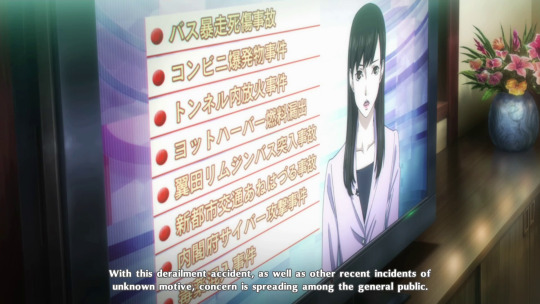
This is the list of incidents that appears in the background on TV, in the 10/4 cinematic with Sae, the SIU Director, and Akechi. Let's take a look at them, one by one, to see (some of?) what's been going on.
バス暴走死傷事故 basu bousou shishou jiko reckless bus driving accident that caused injuries and deaths
This is explicitly described as a bousou—the word meaning "runaway" or "rampage" that the original name for "psychotic breakdown" uses, and the original name for Call of Chaos uses. In this context, it means reckless driving. Also shishou is "deaths and injuries"—this is explicitly a fatal accident. The game wants us to know that, even if nobody died in that subway crash, people have died in these mysterious incidents.
コンビニ爆発物事件 konbini bakuhatsumono jiken convenience store bombing incident
What? Did someone bomb a convenience store? Well, maybe not. If you're following the news, the recent incident where someone threw a smoke bomb at PM Kishida Fumio is being described as a bakuhatsumono jiken. So this could be relatively tame.
Or it might not be. The Manchester Arena bombing, where people leaving an Ariana Grande concert were blown up and many died, is also a bakuhatsumono jiken. It could go either way.
トンネル内放火事件 tonneru nai houka jiken arson inside a tunnel incident
Short and sweet. Could be another subway incident, but since it's not explicitly mentioned as being one, it's more likely a road tunnel or something? Fires in tunnels can be devastating, of course.
ヨットハーバー燃料漏出 yotto haabaa nenryou roushutsu marina fuel leak
This sounds like another one that could have been quite dramatic. Marinas tend to be places where rich and powerful people hang out, so this is likely to do with someone being explicitly targetted?
翼田リムジンバス突入事故 yokuta (?) rimushinbasu totsunyuu jiko Yokuta (?) Airport shuttle bus crash accident
Hahaha, this one is fun. First, a "limousine bus" is an airport bus—the ones that run you out to the plane. The airport is a spoof of Haneda Airport. 羽田 "Haneda", to Yokuta (?)'s 翼田—they've changed the first kanji for another one that means "wing".
A totsunyuu jiko is a car crash, but seems to be specifically a crash where the vehicle crashes into a fixed obstacle? So some poor driver smashed their shuttle bus into a wall.
新都市交通あねはづる事故 shin toshi koutsuu anehazuru jiko Anehazuru Monorail case
This one is a P3 reference. shin toshi koutsuu—"New Urban Transport", a term for a "people mover" or monorail. The Shin Toshi Koutsuu Anehazuru is the monorail in P3.
We don't know what happened there, but this may be the only indication that anything happens outside Tokyo in P5 (besides Shido getting his drama on with Joker).
An anehazuru, BTW, is a type of bird, the demoiselle crane.
内閣部サイバー攻撃事件 naikakufu saibaa kougeki jiken Cabinet Office cyberattack incident
This one is interesting because it's so unlike the rest—though there are a lot of data leaks during the Medjed arc, which suggests the conspiracy is somehow taking the opportunity to carry them out. Cyberattacks certainly don't seem in Akechi's line (though he might be responsible for locating worthwhile targets?), so this might just have been swept in with the accidents and "incidents".
An attack on the Cabinet Office, of course, makes it a political attack, and exceptionally likely to be Shido-motivated somehow.
毒薬混入事件 dokuyaku kon'nyuu jiken poison adulteration incident; poisoning incident.
The last on the list: someone, or several someones, were poisoned.
so what do we know
While only one of these, the top one, is explicitly described as fatal, it doesn't take much of a stretch to see that many of them could have been fatal—and the fact that they aren't all called "fatal accident" doesn't make them necessarily not fatal.
Plus, the list fills the screen. These are unlikely to be all the cases; they're the most recent ones, or the ones the studio thought most worthy of note.
481 notes
·
View notes
Photo

'Boxingman in Redroom' by Kazuma Kaneko and Megumi Shiraishi, 2003. Scanned at 800 DPI, 8375x11951 (image above is compressed for Tumblr, check out the link. It won’t preview on Google Drive though, since it’s over 250mb).
https://drive.google.com/drive/folders/1xwyT5lNIiE8myFIEtK0QaPQk05DgXwsL?usp=share_link
This piece was drawn for the cover of Comickers Quarterly Spring 2003, which featured a segment on Kaneko's art process and some of his new Nocturne stuff. I’ve scanned the cover and interview previously, found here, and you can find a translation from Dijeh here.
Boxingman in Redroom wasn’t drawn for a particular game or novel or anything, it’s an entirely original piece of art for the magazine (despite how much I might think the guy’s face looks like Eikichi, and the girl in the back looks like a Jiken character). Kaneko had been featured in Comickers twice before, from what I can find, in Autumn 2000 and Winter 2003 (and again in Winter 2005, I’ve scanned them all here. Even still, ATLUS owns the copyright to the piece (I clone-stamped this text below out in the final scan).

Anyway, ‘boxingman’ has a double meaning, firstly of the guy's ‘desire to enter small places’, to be boxed in, and secondly because he’s wearing boxers. Maybe he was kidnapped or something, notice the lock of sorts around his neck, and he’s most notably the least red thing in the room. He looks pretty mischievous if that’s the case though, maybe he snuck in? In which case, I’m not sure why the lady in the back would be holding a razor blade. This is probably the kind of mystery Kaneko was trying to excite in the viewer. Not sure what the chameleon is adding to the story of the art, but he’s probably just chill like that. The stone mask could be a JoJo's Bizarre Adventure reference, but that’s what everyone says about any stone mask in anything, so who knows.
The colours were annoying to work with, so depending on your screen, this might look completely different to how I see it. It scanned in far too orange, now the red still looks is a little too orange on my laptop screen, but on my monitor it looks a little too magenta and the guy looks too yellow. Looks in-between on my phone. You can try print this out for your wall or something if you’d like, but I’m not sure how the colours would come out. It’s meant to be a really nice, extremely dark red though, sort of like Gozu-tennoh's face.

Anyway, enjoy besties, put it as your phone’s home-screen or something. I’ll try post more of my things on Tumblr.
506 notes
·
View notes
Text
The Apothecary Diaries Season 2 Teaser PV 2 / 薬屋のひとりごと 第2期ティザーPV 第2弾
Please note that English sentences are just my translation.
『新章、開幕――』
“Shinsho, kaimaku――”
“New chapter begins――”
猫猫「壬氏様、何かご用でしょうか」
Maomao “Jinshi-sama, nanika goyo deshoka.”
Maomao “Master Jinshi, is there anything I can help you with?”
壬氏「薬屋。少し、調べてほしいことがあるのだが―」
Jinshi “Kusuriya. Sukoshi, shirabete-hoshii-kotoga aruno-daga―”
Jinshi “Apothecary. I’d like you to look into something.”
猫猫(また面倒ごとか… いや、待てよ…)
Maomao (Mata mendo-gotoka… Iya, mateyo…)
Maomao (Another trouble again… No, wait a minute…)
猫猫「それ、詳しく聞かせてくれませんか?」
Maomao “Sore, kuwashiku kikasete kure-masenka?”
Maomao “Can you tell me more about that?”
『原作 日向夏 『薬屋のひとりごと』 ヒーロー文庫/イマジカインフォス刊』
Gensaku Hyuga-Natsu “Kusuriya-no Hitori-goto” Hīrō bunko / Imajika-Infosu-kan
Original: “The Apothecary Diaries” written by Natsu Hyuga, published by Hero Bunko, Imagica Infos
語り「薬屋の少女が挑む、謎解きエンターテイメントが、今、再び幕を開けるー」
Katari “Kusuriya-no shojoga idomu, nazo-toki entāteimento-ga, ima, futatabi maku’o akeru―”
Narration “Now, the curtain is rising on another entertaining mystery for our young apothecary to challenge.”
『宮中に渦巻く暗雲』
“Kyuchu-ni uzu-maku an-un”
“Dark clouds, swirling in the palace”
猫猫「考え過ぎだと思いたいが…」
Maomao “Kangae-sugi-dato omoi-taiga…”
Maomao “I’d like to think I’m overthinking it, but…”
『ふたりを待ち受ける、新たな難事件』
“Futari’o machi-ukeru, aratana nan-jiken”
“A new difficult case awaits the two.”
猫猫「何だか引っかかる…」
Maomao “Nandaka hikkakaru…”
Maomao “Something’s stuck in my mind…”
壬氏「一体誰が……」
Jinshi “Ittai darega……”
Jinshi “Who on earth…”
猫猫「憶測にすぎませんが、これ、あの事件に似てるとは思いませんか?」
Maomao “Okusoku-ni sugi-masenga, kore, ano jikenni niteru-towa omoi-masenka?”
Maomao “This is just speculation, but don’t you think this is similar to that incident?”
壬氏「――まさか!」
Jinshi “――Masaka!”
Jinshi “――No way!”
猫猫「壬氏様」
Maomao “Jinshi-sama.”
Maomao “Master Jinshi.”
壬氏「ああ。薬屋、行くぞ」
Jinshi “Aa. Kusuriya, ikuzo.”
Jinshi “Yes. Let’s go, Apothecary.”
『毒を、暴け―――』
“Doku’o, abake―――”
“Expose the poison――”
『薬屋のひとりごと』
“Kusuriya-no Hitori-goto”
“The Apothecary Diaries”
『2025年1月10日(金)放送開始』
“Nisen-niju-go-nen ichi-gatsu tooka (Kin) hoso-kaishi”
“Broadcast begins on Friday, January 10, 2025.”
語り「薬屋のひとりごと、第2期。2025年1月10日、放送開始」
Katari “Kusuriya-no Hitori-goto, dai-niki. Nisen-niju-go-nen ichi-gatsu tooka, hoso-kaishi.”
Narration “The Apothecary Diaries, Season 2. Broadcast begins on January 10, 2025.”
『毎週金曜よる11:00より、FRIDAY ANIME NIGHT(フラアニ) 日本テレビ系30局ネットにて全国同時放送!放送終了後、各種配信プラットフォームでも順次配信予定! *放送日時は予告なく変更になる場合がございま��』
“Maishu kin-yo yoru ju-ichi-ji-yori, Furaidē Anime Naito (Fura-Ani) Nihon-Terebi-kei sanjukkyoku-netto-nite zen-koku doji hoso! Hoso shuryogo, kakushu haishin puratto-fōmu-demo junji haishin yotei! *Hoso-nichijiwa yokoku-naku henkoni naru baaiga gozai-masu.”
“Every Friday night from 11:00 p.m., by Friday Anime Night (Fura-Ani), it will be broadcast simultaneously nationwide on 30 Nippon Television Network stations! After the broadcast, it will be distributed sequentially on various streaming services! *Broadcast dates and times may be subject to change without notice.”
『CAST 猫猫 : 悠木碧 壬氏 : 大塚剛央 高順 : 小西克幸 玉葉妃 : 種崎敦美 梨花妃 : 石川由依 里樹妃 : 木野日菜 小蘭 : 久野美咲 ナレーション : 島本須美』
“Kyasuto Maomao: Yuki Aoi Jinshi: Otsuka Takeo Gaoshun: Konishi Katsuyuki Gyokuyo-hi: Tanezaki Atsumi Rifa-hi: Ishikawa Yui Rīshu-hi: Kino Hina Shaoran: Kuno Misaki Narēshon: Shimamoto Sumi”
“Cast Maomao: Aoi Yuki, Jinshi: Takeshi Otsuka, Gaoshun: Katsuyuki Konishi, Concubine Gyokuyou: Atsumi Tanezaki, Concubine Lihua: Yui Ishikawa, Concubine Lishu: Hina Kino, Shaolan: Misaki Kuno, Narration: Sumi Shimamoto”
『STAFF 原作 : 薬屋のひとりごと(ヒーロー文庫/イマジカインフォス刊) キャラクター原案 : しのとうこ…』
“Staffu Gen-saku: Kusuriyano Hitorigoto (Hīrō bunko / Imajika-Infosu-kan) Kyarakutā gen-an: Shino Touko…”
“Staff Original : The Apothecary Diaries (published by Hero Bunko, Imagica Infos), Character draft: Touko Shino…”
―――――――――――――――――――――――――――――――
I would like to ask if there’s better English sentence for the green-colored translation.
#apothecary english#apothecary romaji#the apothecary diaries#apothecary diaries#learning japanese#japanese#薬屋のひとりごと#薬屋のひとりごと 英語#薬屋 英語 学習#japan#KNH
10 notes
·
View notes
Text
30 days Hypnosis Mic challenge
DAY 9: favorite duet song
🎤 「Murder at the House of Magic (奇術館の殺人 / Kijutsu-kan no Satsujin) 」 - Gentaro & Dice (2nd duet)
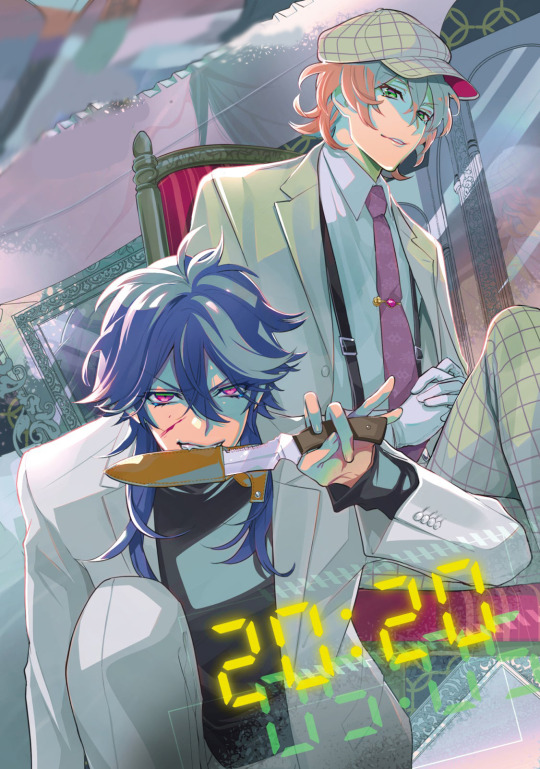
(link)
Just to make it immediately clear: my obsession level is high (yes, this post is going to be super long, and yes, I apologize in advance for that). I'm not exaggerating when I say that I know every single word of this song by heart. I even made a fanart for this song. Check it out, if you're curious 👉 (link)
I became aware of the existence of this duet far too late, in April 2022, i think??, and in the saddest way possible: through the wiki while searching for only God knows now what kind of other stuff. Of course, considering that Dice and Gentaro are two of my fave characters ever, it was a scandal for me not to have known earlier about the existence of a new duet of theirs, other than Once upon a time in Shibuya, which is iconic in itself, so I went crazy, obviously, and dashed off in search of the song (with very little success, I have to say)... and when I finally found it and it started playing, I almost had a heart attack. What. the actual. hell. was. that.
I expected everything, except something of that sort.
Right from the very first notes, I knew this was gonna be BIG stuff. I mean, VERY BIG.
The vibe it gave me, initially, was something alien, the instrumental intro smelled a lot like the X-files theme song to me (link).
Then Gentaro started, in his usual calm and sexy tone, and I caught the word "satsujin jiken". But so far, let's say, nothing exceptionally new. I knew I should expect some mystery to solve... I mean, the title spoke loud ¯\(ツ)/¯
But poor little naive Anna, soon after the bomb was dropped straight to the center of an indefinite part of my brain.
A serious Dice.
A bloody serious Dice. A Dice that, instead of rapping, was literally speaking (or at least, the initial impression was seriously that). I...I've never heard Dice speaking in such a hard, deadly serious yet sexy, defiant, cocky and confident tone, like... I- ... I didn't even think he could ever speak in such a way!? Like. Dice. HELLO?! Where is my genuine idiotic cute drenched cat gone?! I'm scared?? But at the same time extremely intrigued?? WTF?! Help??!! Let's make one thing clear: when I first heard the song, I obviously had not read the translation yet. So, how shall I explain what I thought ... mhm... the impression was that he was speaking not in a good-guy-trying-to-be-cool sense, absolutely not. His tone was blatantly the tone of a thug. And a particularly dangerous one. The impact of the very first verse of his, "Danna shindanda na, zannen da" was something absurd. I swear. Something of disarming power. And then the tone used in the "tamannee na" immediately afterwards. Guys, I swear to you. I had completely lost my mind. I was totally in love with this new Dice, you have no idea. I was going crazy, I just wanted to know WHY he was talking in that absolutely crazy HOT way. I LOVE how it's clearly perceivable that Dice is speaking with a smirk on his face, that of someone who is sure that he cannot be set up. And I could go on listing word by word all the vocal proclivities that have slowly sent me further and further into the hyperuranium BUT I will refrain from doing so for your sake, because this post would probably become longer than it already is going to be. And then the refrain. Simply BRILLIANT. I mean, it's already not enough that this too, like Stella, is a song set up as a story told by Gentaro, in which he then becomes one of the characters in the plot (you can't tell I have logic behind my preferences, can you?), but a semi-occult code was also inserted?????? Who the hell came up with the idea of putting the spelling of Dice and Gentaro's names at the beginning of each verse of the chorus? WHO? Give a fucking award to the composer, I beg you: (A)Up & down, Rikou na yatsu wo, Sukkari damashite Ganchuu nai Wakattenda Dare na no ka Izure wa Subete wo raizarai;
Yurusan, Meshi toraeru, Nogasanai shi Genkei nai Takara, Rou sezu shite, Umaku moratte Say Good Bye I don't know if i'm making the point clear enough, here.
And then the whole Uh!(Ah!)Uh!Uh!(Ah!) thing. Gentaro firing off his "Ichi wa ichi, zero wa zero, hachi wa hachi" with that studied air of his who knows he has the other guy completely on the hook. And the way you can perfectly sense that the mood of the conversation is starting to turn against Dice, when he throws out that "Nani?!" and then that "Kuso!" so particularly intense (KYAAAAAHHH (⁄ ⁄>⁄ ▽ ⁄<⁄ ⁄)).
OH, and I can't help but mention how the "Hachiji nijuppun" thing practically became a meme between me and @justanotherniky (fixed message in chat at 8:20 p.m.: "HACHIJI NIJUPPUN" when we don't happen to forget about it).
I swear guys, you have no idea how much I lost my mind behind this duet. Because c'mon, I don't know if you guys are realizing, but it's fucking genius. And, last but not least, how not to mention the classic "Uso desu kedo ne~" at the close. Epic.
#hypnosis mic#hypmic#30 days hypnosis mic challenge#day 9#30 day challenge#murder at the house of magic#kijutsukan no satsujin#奇術館の殺人#fling posse#yumeno gentaro#gentaro yumeno#arisugawa dice#dice arisugawa#gendice#fp & m +#anime#manga#japanese rap
41 notes
·
View notes
Photo

Sanma no Meitantei
Sanma no Meitantei (or “Great Detective Sanma”) is an interesting footnote in the history of early Japanese adventure games. It’s a crossroads of sorts between the release of detective-based murder mysteries inspired by Yuji Horii’s Portopia Renzoku Satsujin Jiken, and – of all things – the Japanese stand-up comedy scene of the mid-80s. This is clear from the get-go, since it stars renowned comedian Sanma Akashiya as the titular great detective, along with a host of famous double acts and comedians of the day who populate the game world.
Read more...
#Hardcore Gaming 101#Apollo Chungus#Review#Sanma no Meitantei#Japanese adventure#comedy#Famicom#murder mystery#Namco#NES#wacky#over the top#video games
121 notes
·
View notes
Text
Helllooooooo!! And so it begins, Op4 lyrics time. Thanks as always to @alphardofthealley for scans of the lyrics booklet. <3
This one's a very soft and very cute song for John and Sherlock. I absolutely LOVED the roof scene in the manga, and I believe this song managed to double/triple/quadruple just how soft this scene is. Enjoy!!
Under this blue sky
この空の下 | Kono sora no shita Characters: Sherlock Holmes, John H. Watson
Kanji
ずっと一人だったから お前と一緒に事件を 解決するようになってから 前よりももっと楽しくなった 同じ目線に立って 謎解きの楽しさを 共有できる相棒が お前で良かった だから…
お前がここからいなくなると ちょっと悲しくなるな… でも、だからっていつあでもお前に ここにいてくれてって言うの違う それは多分”依存”とか ”支配”ってやつだから 俺はメアリーを見極めようとした 彼女を試す様な真似もした その理由がやっと分かった お前に幸せになって欲しいからだ
あぁ… そう願うこの気持ち… これがきっと”友情”って やつなんだな
友情 友情 お前の口から そんな言葉が出て来るなんて そんな風に俺を想ってくれて 叫びたいくらいに嬉しいよ!
俺は結婚したとしても お前の相棒を辞める訳じゃない お前と一緒に事件解決するのは 俺の生き甲斐なんだ!
「…約束だ、ジョン。」 俺との友情信じるなら この先どんなことがあっても
お前はお前の幸せを掴め お前の幸せこそが… 俺の幸せなんだからな
あぁ約束する 誓いを立てる この空の下 お前に この空の下 お前に この空の下 お前に
Romaji
Zutto hitori datta kara omae to issho ni jiken wo Kaiketsu suru you ni natte kara mae yori mo motto tanoshikunatta Onaji mesen ni tatte nazotoki no tanoshisa wo Kyouyuu dekiru aibou ga omae de yokatta dakara... Omae ga koko kara inakunaru to chotto kanashiku naru na...
Demo, dakara tte itsumademo omae ni koko ni ite kure tte iu no wa chigau Sore wa tabun “izon” toka “shihai” tte yatsu dakara Ore wa Mary wo mikiwameyou to shita kanojo wo tamesu you na mane mo shita Sono riyuu ga yatto wakatta omae ni shiawase ni natte hoshii kara da
Ah Sou negau kono kimochi... Kore ga kitte “yuujou” tte yatsu nanda na
Yuujou yuujou Omae no guchi kara sonna kotoba ga detekuru nante Sonna fuu ni ore wo omotte kurete sakebitai kurai ureshii yo!
Ore wa kekkon shita to shite mo omae no aibou wo yameru wake ja nai Omae to issho ni jiken kaiketsu suru no wa ore no ikigai nanda!
...Yakusoku da, John. Ore to no yuujou shinjiru nara kono saki donna koto ga attemo Omae wa omae no shiawase wo tsukame omae no shiawase koso ga Ore no shiawase nanda kara na
Ah yakusoku suru chikai wo tateru kono sora no shita omae ni Kono sora no shita omae ni Kono sora no shita omae ni
English
Sherlock: Please. What are you saying, John? I’ve always thought highly of you. John: Really, Sherlock?
I had always been alone And when you came along, solving mysteries became a lot more fun I realized how fun it is having a partner on my side A partner I can work well with, I’m glad that partner is you Which is why I feel a bit sad knowing that you’re leaving
Still, that’s not enough reason to ask you to stay If I do (ask you to stay), I’d be “dependent” on you, or maybe I’d be “taking control” of you I finally understand why I tried to probe Mary, and even tested her And that’s because I just want you to be happy
Ah Yes, this feeling... It must be “friendship”
“Friendship” “Friendship”... Who would have thought the day would come when I’d hear that from your lips? And to think you’d think that about me... I’m so happy I could scream!
John: Sherlock! Sherlock: Wha! Idiot! Don’t just suddenly hug me! John: Come on. It’s fine, right? Sherlock: It’s weird. Let go of me! John: But, don’t get the wrong idea, Sherlock.
Even if I get married, I won’t stop being your partner Because solving cases with you is my life’s purpose!
That’s a promise, John. If you think my friendship is true, know that regardless of what happens from now on Just go and grab onto your happiness Because what makes you happy makes me happy.
Yes, I promise. I swear this oath to you, under this blue sky Under this blue sky, I swear to you Under this blue sky, I swear to you
John: Let’s make sure everything goes well tomorrow! Sherlock: Yeah. Let’s do that.
Notes: There's no mention of blue skies, but the weather was shown to be super nice on stage, so I thought I should capture that. I LOVE THIS SCENE.
26 notes
·
View notes
Photo

Artwork for Kasaburanka Ni Ai O 〜Satsujinsha Wa Jikū O Koete〜 by Akira Yoneda (aka Akira Komeda), a 1986 Thinking Rabbit game for the PC-8800, PC-9801, FM-7 and Sharp X1 computer series. This is the third entry in the Disc Mysteries series of computer text adventure murder stories, following Dokeshi Satsu Jinjiken and Kagiana Satsujin Jiken.
I became aware of this game due to Riverhill Soft's Windows 95 port, itself an adaptation of Thinking Rabbit's reissuing of the original game for the 3D0 from 1994, including a soundtrack and completely redone color graphics. The game is set in the 1940s and tells the story of a journalist whose high-school friend goes missing. A more atypical twist takes place when she discovers that this friend’s father, allegedly pursued and stabbed to death by members of the government, had invented a time machine.
The rather conspicuous reference to Casablanca and its leading actors, Bogart and Bergman, were erased from later ports (see the 3DO and the Win95 covers); the title also having been sanitized to Toki O Koeta Tegami, or The Letter That Over Came Time. Similarly, allusions to the time travelling theme were much more subtle than in this preciously sinister illustration, whose muted hues and composition bring to mind an Andrew Wyeth landscape.
11 notes
·
View notes
Text
For our next profile for Writers in Horror Month 2023 we have Edogawa Ranpo…
Born Tarō Hirai
October 21, 1894
Mie, Empire of Japan
Died July 28, 1965 (aged 70)
Occupation Novelist, literary critic
Language Japanese
Nationality Japanese
Alma mater Waseda University
Genre Mystery, weird fiction, thriller
Tarō Hirai (平井 太郎, Hirai Tarō, October 21, 1894 – July 28, 1965), better known by the pen name Edogawa Ranpo (江戸川 乱歩)[a] was a Japanese author and critic who played a major role in the development of Japanese mystery and thriller fiction. Many of his novels involve the detective hero Kogoro Akechi, who in later books was the leader of a group of boy detectives known as the "Boy Detectives Club" (少年探偵団, Shōnen tantei dan).
Ranpo was an admirer of Western mystery writers, and especially of Edgar Allan Poe. His pen name is a rendering of Poe's name. Other authors who were special influences on him were Sir Arthur Conan Doyle, whom he attempted to translate into Japanese during his days as a student at Waseda University, and the Japanese mystery writer Ruikō Kuroiwa.
Biography
Before World War II
Tarō Hirai was born in Nabari, Mie Prefecture in 1894, where his grandfather had been a samurai in the service of Tsu Domain. His father was a merchant, who had also practiced law. The family moved to what is now Kameyama, Mie, and from there to Nagoya when he was age two. At the age of 17, he studied economics at Waseda University in Tokyo starting in 1912. After graduating in 1916 with a degree in economics, he worked a series of odd jobs, including newspaper editing, drawing cartoons for magazine publications, selling soba noodles as a street vendor, and working in a used bookstore.
In 1923, he made his literary debut by publishing the mystery story "The Two-Sen Copper Coin" (二銭銅貨, Ni-sen dōka) under the pen name "Edogawa Ranpo" (pronounced quickly, this humorous pseudonym sounds much like the name of the American pioneer of detective fiction, Edgar Allan Poe, whom he admired). The story appeared in the magazine Shin Seinen, a popular magazine written largely for an adolescent audience. Shin Seinen had previously published stories by a variety of Western authors including Poe, Arthur Conan Doyle, and G. K. Chesterton, but this was the first time the magazine published a major piece of mystery fiction by a Japanese author. Some, such as James B. Harris (Ranpo's first translator into English), have erroneously called this the first piece of modern mystery fiction by a Japanese writer,[3] but well before Ranpo entered the literary scene in 1923, a number of other modern Japanese authors such as Ruikō Kuroiwa, Kidō Okamoto, Jun'ichirō Tanizaki, Haruo Satō, and Kaita Murayama had incorporated elements of sleuthing, mystery, and crime within stories involving adventure, intrigue, the bizarre, and the grotesque.[4] What struck critics as new about Ranpo's debut story "The Two-Sen Copper Coin" was that it focused on the logical process of ratiocination used to solve a mystery within a story that is closely related to Japanese culture.[5] The story involves an extensive description of an ingenious code based on a Buddhist chant known as the "nenbutsu" as well as Japanese-language Braille.
Over the course of the next several years, Edogawa went on to write a number of other stories that focus on crimes and the processes involved in solving them. Among these stories are a number of stories that are now considered classics of early 20th-century Japanese popular literature: "The Case of the Murder on D. Hill" (D坂の殺人事件, D-zaka no satsujin jiken, January 1925), which is about a woman who is killed in the course of a sadomasochistic extramarital affair, "The Stalker in the Attic" (屋根裏の散歩者, Yane-ura no Sanposha, August 1925), which is about a man who kills a neighbor in a Tokyo boarding house by dropping poison through a hole in the attic floor into his mouth, and "The Human Chair" (人間椅子, Ningen Isu, October 1925), which is about a man who hides himself in a chair to feel the bodies on top of him Mirrors, lenses, and other optical devices appear in many of Edogawa's other early stories, such as "The Hell of Mirrors".
Although many of his first stories were primarily about sleuthing and the processes used in solving seemingly insolvable crimes, during the 1930s, he began to turn increasingly to stories that involved a combination of sensibilities often called "ero guro nansensu", from the three words "eroticism, grotesquerie, and the nonsensical" The presence of these sensibilities helped him sell his stories to the public, which was increasingly eager to read his work. One finds in these stories a frequent tendency to incorporate elements of what the Japanese at that time called "abnormal sexuality" (変態性欲, hentai seiyoku). For instance, a major portion of the plot of the novel The Demon of the Lonely Isle (孤島の鬼, Kotō no oni), serialized from January 1929 to February 1930 in the journal Morning Sun (朝日, Asahi), involves a homosexual doctor and his infatuation for another main character.
By the 1930s, Edogawa was writing regularly for a number of major public journals of popular literature, and he had emerged as the foremost voice of Japanese mystery fiction. The detective hero Kogorō Akechi, who had first appeared in the story "The Case of the Murder on D. Hill" became a regular feature in his stories, a number of which pitted him against a dastardly criminal known as the Fiend with Twenty Faces (怪人二十面相, Kaijin ni-jū mensō), who had an incredible ability to disguise himself and move throughout society. (A number of these novels were subsequently made into films.) The 1930 novel introduced the adolescent Kobayashi Yoshio (小林芳雄) as Kogoro's sidekick, and in the period after World War II, Edogawa wrote a number of novels for young readers that involved Kogoro and Kobayashi as the leaders of a group of young sleuths called the "Boy Detectives Club" (少年探偵団, Shōnen tantei dan). These works were wildly popular and are still read by many young Japanese readers, much like the Hardy Boys or Nancy Drew mysteries are popular mysteries for adolescents in the English-speaking world.
During World War II
In 1939, two years after the Marco Polo Bridge Incident and the outbreak of the Second Sino-Japanese War in 1937, Edogawa was ordered by government censors to drop his story "The Caterpillar" (芋虫, Imo Mushi), which he had published without incident a few years before, from a collection of his short stories that the publisher Shun'yōdō was reprinting. "The Caterpillar" is about a veteran who was turned into a quadriplegic and so disfigured by war that he was little more than a human "caterpillar", unable to talk, move, or live by himself. Censors banned the story, apparently believing that the story would detract from the current war effort. This came as a blow to Ranpo, who relied on royalties from reprints for income. (The short story inspired director Kōji Wakamatsu, who drew from it his movie Caterpillar, which competed for the Golden Bear at the 60th Berlin International Film Festival.)
Over the course of World War II, especially during the full-fledged war between Japan and the US that began in 1941, Edogawa was active in his local neighborhood organization, and he wrote a number of stories about young detectives and sleuths that might be seen as in line with the war effort, but he wrote most of these under different pseudonyms as if to disassociate them with his legacy. In February 1945, his family was evacuated from their home in Ikebukuro, Tokyo to Fukushima in northern Japan. Edogawa remained until June, when he was suffering from malnutrition. Much of Ikebukuro was destroyed in Allied air raids and the subsequent fires that broke out in the city, but the thick, earthen-walled warehouse which he used as his studio was spared, and still stands to this day beside the campus of Rikkyo University.
Postwar
In the postwar period, Edogawa dedicated a great deal of energy to promoting mystery fiction, both in terms of the understanding of its history and encouraging the production of new mystery fiction. In 1946, he put his support behind a new journal called Jewels (宝石, Hōseki) dedicated to mystery fiction, and in 1947, he founded the Detective Author's Club (探偵作家クラブ, Tantei sakka kurabu), which changed its name in 1963 to the Mystery Writers of Japan (日本推理作家協会, Nihon Suiri Sakka Kyōkai). In addition, he wrote a large number of articles about the history of Japanese, European, and American mystery fiction. Many of these essays were published in book form. Other than essays, much of his postwar literary production consisted largely of novels for juvenile readers featuring Kogorō Akechi and the Boy Detectives Club.
In the 1950s, he and a bilingual translator collaborated for five years on a translation of Edogawa's works into English, published as Japanese Tales of Mystery and Imagination by Tuttle. Since the translator could speak but not read Japanese, and Edogawa could read but not write English, the translation was done aurally, with Edogawa reading each sentence aloud, then checking the written English.[3]
Another of his interests, especially during the late 1940s and 1950s, was bringing attention to the work of his dear friend Jun'ichi Iwata (1900–1945), an anthropologist who had spent many years researching the history of homosexuality in Japan. During the 1930s, Edogawa and Iwata had engaged in a light-hearted competition to see who could find the most books about erotic desire between men. Edogawa dedicated himself to finding books published in the West and Iwata dedicated himself to finding books having to do with Japan. Iwata died in 1945, with only part of his work published, so Edogawa worked to have the remaining work on queer historiography published
In the postwar period, a large number of Edogawa's books were made into films. The interest in using Edogawa's literature as a departure point for creating films has continued well after his death. Edogawa, who had a variety of health issues, including atherosclerosis and Parkinson's disease, died from a cerebral hemorrhage at his home in 1965. His grave is at the Tama Cemetery in Fuchu, near Tokyo.
The Edogawa Rampo Prize (江戸川乱歩賞 Edogawa Ranpo Shō?), named after Edogawa Rampo, is a Japanese literary award which has been presented every year by the Mystery Writers of Japan since 1955. The winner is given a prize of ¥10 million with publication rights by Kodansha.
Works in English translation
Books
• Edogawa Rampo (1956), Japanese Tales of Mystery and Imagination, translated by James B. Harris. 14th ed. Rutland, VT: Charles E. Tuttle Company. ISBN 978-0-8048-0319-9.
• Edogawa Ranpo (1988), The Boy Detectives Club, translated by Gavin Frew. Tokyo: Kodansha. ISBN 978-4-0618-6037-7.
• Edogawa Rampo (2006), The Black Lizard and Beast in the Shadows, translated by Ian Hughes. Fukuoka: Kurodahan Press. ISBN 978-4-902075-21-2.
• Edogawa Rampo (2008), The Edogawa Rampo Reader, translated by Seth Jacobowitz. Fukuoka: Kurodahan Press. ISBN 978-4-902075-25-0. Contains many of Rampo's early short stories and essays.
• Edogawa Rampo (2009), Moju: The Blind Beast, translated by Anthony Whyte. Shinbaku Books. ISBN 978-1840683004.
• Edogawa Rampo (2012), The Fiend with Twenty Faces, translated by Dan Luffey. Fukuoka: Kurodahan Press. ISBN 978-4-902075-36-6.
• Edogawa Ranpo (2013), Strange Tale of Panorama Island, translated by Elaine Kazu Gerbert. Honolulu: University of Hawaiʻi Press. ISBN 978-0824837037.
• Edogawa Rampo (2014), The Early Cases of Akechi Kogoro, translated by William Varteresian. Fukuoka: Kurodahan Press. ISBN 978-4-902075-62-5.
• Edogawa Rampo (2019), Gold Mask, translated by William Varteresian. Fukuoka: Kurodahan Press. ISBN 978-4909473066.
Short stories
• Edogawa Ranpo (2008), "The Two-Sen Copper Coin," translated by Jeffrey Angles, Modanizumu: Modernist Fiction from Japan, 1913–1938, ed. William Tyler. Honolulu: University of Hawai'i Press. ISBN 978-0-8248-3242-1. pp. 270–89.
• Edogawa Ranpo (2008), "The Man Traveling with the Brocade Portrait," translated by Michael Tangeman, Modanizumu: Modernist Fiction from Japan, 1913–1938, ed. William Tyler. Honolulu: University of Hawai'i Press. ISBN 978-0-8248-3242-1. pp. 376–393.
• Edogawa Ranpo (2008), "The Caterpillar," translated by Michael Tangeman, Modanizumu: Modernist Fiction from Japan, 1913–1938, ed. William Tyler. Honolulu: University of Hawai'i Press. ISBN 978-0-8248-3242-1. pp. 406–422.
Major works
Private Detective Kogoro Akechi series
Main article: Kogoro Akechi
• Short stories
o "The Case of the Murder on D. Hill" (D坂の殺人事件, D-zaka no satsujin jiken, January 1925)
o "The Psychological Test" (心理試験, Shinri Shiken, February 1925)
o "The Black Hand Gang" (黒手組, Kurote-gumi, March 1925)
o "The Ghost" (幽霊, Yūrei, May 1925)
o "The Stalker in the Attic" (屋根裏の散歩者, Yaneura no Sanposha, August 1925)
o "Who" (何者, Nanimono, November 1929)
o "The Murder Weapon" (兇器, Kyōki, June 1954)
o "Moon and Gloves" (月と手袋, Tsuki to Tebukuro, April 1955)
• Novels
o The Dwarf (一寸法師, Issun-bōshi, 1926)
o The Spider-Man (蜘蛛男, Kumo-Otoko, 1929)
o The Edge of Curiosity-Hunting (猟奇の果, Ryōki no Hate, 1930)
o The Conjurer (魔術師, Majutsu-shi, 1930)
o The Vampire (吸血鬼, Kyūketsuki, 1930) First appearance of Kobayashi
o The Golden Mask (黄金仮面, Ōgon-kamen, 1930)
o The Black Lizard (黒蜥蜴, Kuro-tokage, 1934) Made into a film by Kinji Fukasaku in 1968
o The Human Leopard (人間豹, Ningen-Hyō, 1934)
o The Devil's Crest (悪魔の紋章, Akuma no Monshō, 1937)
o Dark Star (暗黒星, Ankoku-sei, 1939)
o Hell's Clown (地獄の道化師, Jigoku no Dōkeshi, 1939)
o Monster's Trick (化人幻戯, Kenin Gengi, 1954)
o Shadow-Man (影男, Kage-otoko, 1955)
• Juvenile novels
o The Fiend with Twenty Faces (怪人二十面相, Kaijin ni-jū Mensō, 1936)
o The Boy Detectives Club (少年探偵団, Shōnen Tantei-dan, 1937)
Standalone mystery novels and novellas
• Available in English translation
o Strange Tale of Panorama Island (パノラマ島奇談, Panorama-tō Kidan, 1926)
o Beast in the Shadows (陰獣, Injū, 1928)
o The Demon of the Lonely Isle (孤島の鬼, Kotō no Oni, 1929-30)
o Moju: The Blind Beast (盲獣, Mōjū, 1931)
• Novels and novellas which have not been translated into English
o Incident at the Lakeside Inn (湖畔亭事件, Kohan-tei Jiken, 1926)
o Struggle in the Dark (闇に蠢く, Yami ni Ugomeku, 1926-27)
o The White-Haired Demon (白髪鬼, Hakuhatsu-ki, 1931-32)
o A Glimpse Into Hell (地獄風景, Jigoku Fūkei, 1931-32)
o The King of Terror (恐怖王, Kyōfu Ō, 1931-32)
o Phantom Bug (妖虫, Yōchū, 1933-34)[15]
o The Great Dark Room (大暗室, Dai Anshitsu, 1936)
o Ghost Tower (幽霊塔, Yūrei tō, 1936) Based on the adaptation of the Meiji-period adaptation of Alice Muriel Williamson's A Woman in Grey by Ruikō Kuroiwa (黒岩涙香).
o A Dream of Greatness (偉大なる夢, Idainaru Yume, 1943)
o Crossroads (十字路, Jūjiro, 1955)
o Petenshi to Kūki Otoko (ぺてん師と空気男, 1959)
Short stories
• Available in English translation
o "The Two-Sen Copper Coin" (二銭銅貨, Ni-sen Dōka, April 1923)
o "Two Crippled Men" (二癈人, Ni Haijin, June 1924)
o "The Twins" (双生児, Sōseiji, October 1924)
o "The Red Chamber" (赤い部屋, Akai heya, April 1925)
o "The Daydream" (白昼夢, Hakuchūmu, July 1925)
o "Double Role" (一人二役, Hitori Futayaku, September 1925)
o "The Human Chair" (人間椅子, Ningen Isu, October 1925)
o "The Dancing Dwarf" (踊る一寸法師, Odoru Issun-bōshi, January 1926)
o "Poison Weeds" (毒草, Dokusō, January 1926)
o "The Masquerade Ball" (覆面の舞踏者, Fukumen no Butōsha, January–February 1926)
o "The Martian Canals" (火星の運河, Kasei no Unga, April 1926)
o "The Appearance of Osei" (お勢登場, Osei Tōjō, July 1926)
o "The Hell of Mirrors" (鏡地獄, Kagami-jigoku, October 1926)
o "The Caterpillar" (芋虫, Imomushi, January 1929)
o "The Traveler with the Pasted Rag Picture" aka "The Man Traveling with the Brocade Portrait" (押絵と旅する男, Oshie to Tabi-suru Otoko, August 1929)
o "Doctor Mera's Mysterious Crimes" (目羅博士の不思議な犯罪, Mera Hakase no Fushigi na Hanzai, April 1931)
o "The Cliff" (断崖, Dangai, March 1950)
o "The Air Raid Shelter" (防空壕, Bōkūgō, July 1955)
• Short stories which have not been translated into English
o "One Ticket" (一枚の切符, Ichi-mai no Kippu, July 1923)
o "A Frightful Mistake" (恐ろしき錯誤, Osoroshiki Sakugo, November 1923)
o "The Diary" (日記帳, Nikkichō, March 1925)
o "The Abacus Tells a Story of Love" (算盤が恋を語る話, Soroban ga Koi o Kataru Hanashi, March 1925)
o "The Robbery" (盗難, Tōnan, May 1925)
o "The Ring" (指環, Yubiwa, July 1925)
o "The Sleepwalker's Death" (夢遊病者の死, Muyūbyōsha no Shi, July 1925)
o "The Actor of a Hundred Faces" (百面相役者, Hyaku-mensō Yakusha, July 1925)
o "Doubts" (疑惑, Giwaku, September–October 1925)
o "Kiss" (接吻, Seppun, December 1925)
o "Scattering Ashes" (灰神楽, Haikagura, March 1926)
o "Monogram" (モノグラム, Monoguramu, July 1926)
o "A Brute's Love" (人でなしの恋, Hitodenashi no Koi, October 1926)
o "The Rocking-Horse's Canter" (木馬は廻る, Mokuba wa Mawaru, October 1926)
o "Insect" (虫, Mushi, Jun-July 1929)
o "Demon" (鬼, Oni, November 1931-February 1932)
o "Matchlock" (火縄銃, Hinawajū, April 1932)
o "Pomegranate" (石榴, Zakuro, September 1934)
o Horikoshi Sōsa Ikkachō-dono (堀越捜査一課長殿, April 1956)
o "The Wife-Broken Man" (妻に失恋した男, Tsuma ni Shitsuren-shita Otoko, October–November 1957)
o "Finger" (指, Yubi) January 1960
Adaptations of Western mystery novels
• The Demon in Green (緑衣の鬼, Ryokui no Oni, 1936) Adaptation of The Red Redmaynes by Eden Phillpotts
• The Phantom's Tower (幽鬼の塔, Yūki no Tō, 1936) Adaptation of The Hanged Man of Saint-Pholien by Georges Simenon
• Terror in the Triangle-Hall (三角館の恐怖, Sankaku-kan no kyōfu, 1951) Adaptation of Murder among the Angells by Roger Scarlett
Essays
• "The Horrors of Film" (1925)
• "Spectral Voices" (1926)
• "Confessions of Rampo" (1926)
• "The Phantom Lord" (1935)
• "A Fascination with Lenses" (1936)
• "My Love for the Printed Word" (1936)
• "Fingerprint Novels of the Meiji Era" (1950)
• "Dickens vs. Poe" (1951)
• "A Desire for Transformation" (1953)
• "An Eccentric Idea" (1954)
These ten essays are included in The Edogawa Rampo Reader.

2 notes
·
View notes
Photo
The funny part is that both of those red rangers are, in fact, ninjas, from two of the ninja-related seasons of Super Sentai/Power Rangers (NinjaRed from Ninja Sentai Kakuranger and HurricaneRed from Ninpu Sentai Hurricaneger — that's Mighty Morphin' Alien Rangers and Power Rangers Ninja Storm), and this is on the moonbase known as the Rabbit Hutch/Hatch (there's several puns going on there).
With Kamen Rider Fourze lurking in the background, wearing a deerstalker and inverness cape for some reason.
... searching... aha! It's from this:


29K notes
·
View notes
Text

Hana to Alice Satsujin Jiken
ENG Title: The Case of Hana & Alice
JP Title: 花とアリス 殺人事件
Drama・Mystery・Slice of Life Movie・1 Episode Year: Winter 2015 Studio: STEVE N' STEVEN Character: Arisugara Tetsuko (有栖川徹子 ) , Hana Arai ( 荒井花 )
#Hana to Alice Satsujin Jiken#The Case of Hana & Alice#The case of hana and alice#花とアリス 殺人事件#STEVE N' STEVEN#winter 2015#2010s anime#10s anime#2015#有栖川徹子#Arisugara Tetsuko#荒井花#Hana Arai#anime
1 note
·
View note
Text
The Most Secret Plot Twist in Gaming History: Punished "Venom" Snake's True Identity Mystery in Metal Gear Solid V The Phantom Pain
youtube
The most secret plot twist in gaming history - Punished "Venom" Snake and Ricardo "Chico" Valenciano Libre being one and the same person in Metal Gear Solid V The Phantom Pain - was foreshadowed multiple times since (but not only...) Metal Gear Solid Peace Walker's Title Sequence (a Hideo Kojima game released in 2010 for the Sony PlayStation Portable originally planned to be titled "Metal Gear Solid 5: Peace Walker")
which shows this mirror breaking transition with two hidden butterflies (suggested play speed 0,25x) revealing - Chico Young volunteer in Snake's private army - the "Hombre Nuevo" chosen for Hideo Kojima's Metal Gear Solid V Experience as its new main protagonist
youtube
(which includes P.T. Silent Hills Concept Movie with the Chico's head appearance...)
youtube
that was, and still is, believed by most of the audience and its english language speaking vocal minority in particular (also known as the "Metal Gear community") to have died in the final helicopter crash cutscenes from Metal Gear Solid V Ground Zeroes showed in this video which was mirrored "for a special reason."
youtube
This crucial hint, hidden in plain sight, was secretly a direct reference left by the Metal Gear mastermind to be seen, and then revisited, only by those "good listeners" among his fans whose minds are still looking for the Truth behind the Hideo Kojima's Metal Gear Solid V Experience in the future MGSV games released years after such as it occurs in this very pivotal moment from MGSVTPP's Episode 46 Truth The Man Who Sold The World ending cutscene when the main protagonist punches the mirror "...for a S-Special reason."
I highly recommend to read the not flipped text printed down below in this Metal Gear Solid V Ground Zeroes' poster showing - Snake A former hero once known by the code name "Big Boss" - revealed during the Metal Gear Saga 25th Anniversary Party for the details...

The text "ƎЯƎH ꓘƆI⅃Ɔ" from Konami's Metal Gear 25th Anniversary Party Special Site was also flipped "for a special reason."
This crucial hint was also a tribute to Yuji Horii's Portopia Renzoku Satsujin Jiken/The Portopia Serial Murder Case in which a butterfly is revealed to be a critical clue for the player trying to solve that mystery
which was one of the most influential games inspiring Hideo Kojima into starting his career as game designer
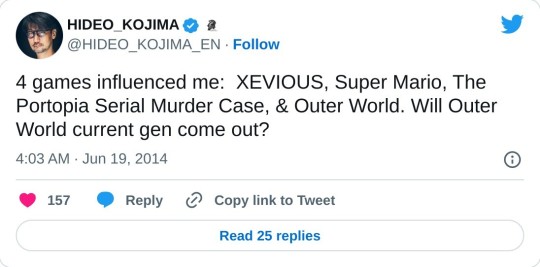


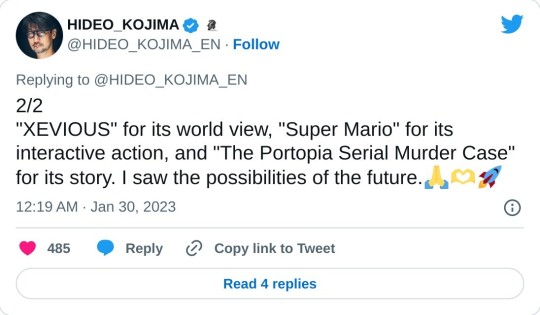
The original version for the NEC PC-6001 cassette tape data loader sound of Portopia Renzoku Satsujin Jiken/The Portopia Serial Murder Case
youtube
was originally included in Metal Gear Solid V Ground Zeroes' "Classified Intel Data" (timestamp 1:01:50)
youtube
and Metal Gear Solid V The Phantom Pain's "Operation Intrude N313" cassette tapes as a clue to solve Punished "Venom" Snake's true identity mystery, the key to decipher the entire Metal Gear Solid V Experience's enigma
youtube
before being changed by the "Metal Gear Development Team" left in Konami after Kojima's departure from the company in October 9th 2015
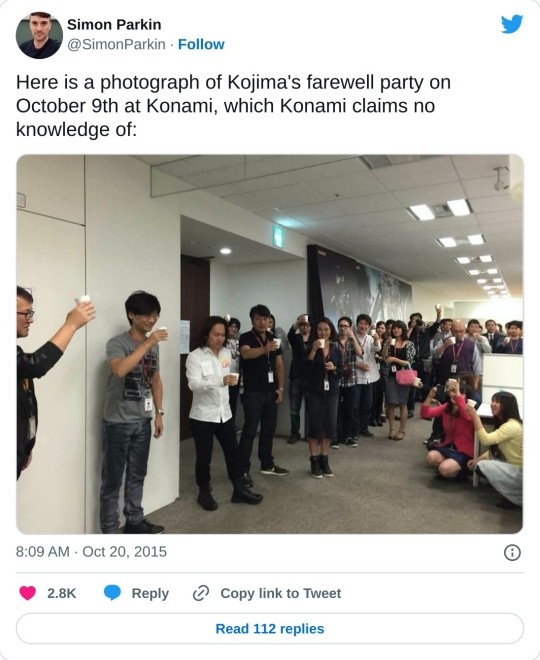
with the MSX version of the original Hideo Kojima's Metal Gear game (here displayed during Metal Gear Solid V Ground Zeroes boot camp held in Nasu on february 2014 in which the japanese game designer is "recreating a scene" from both his past and The Phantom Pain player's future...)
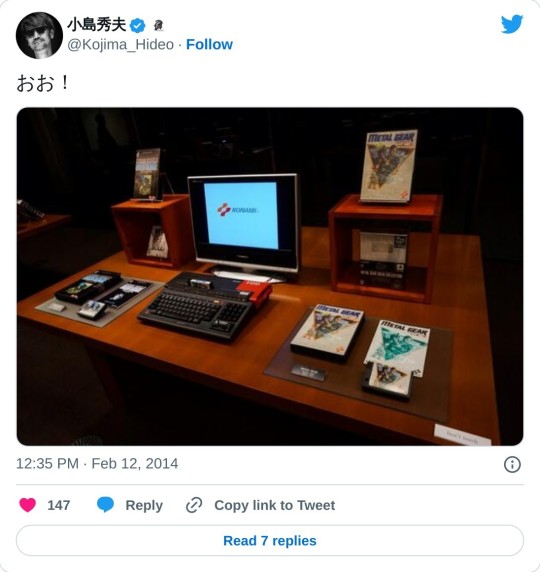
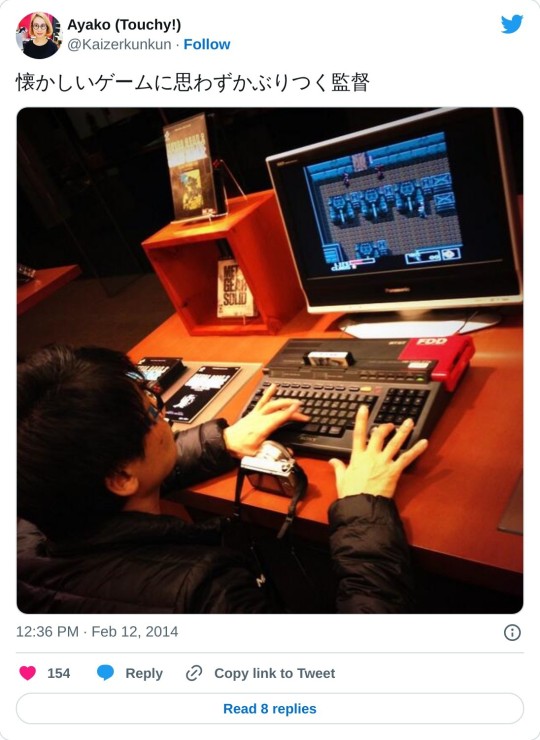

after being discovered by dataminers of the MGSVTPP pc version
in order to trying to keep hidden the most secret plot twist in gaming history before someone would have been able to find it...

...that someone was this online persona known by the username @ItalianJoe83 very long time ago (timestamp 1:41:50)
which social media activities including this video
youtube
weren’t, and are not, affiliated in any capacity with Konami Digital Entertainment like the spreading of this Google document
created and updated for years by Twitter user @HastatusAtratus
explaining in details all the issues still afflicting this Hideo Kojima's "social experiment" known as The Secret Nuclear Disarmament Event of Metal Gear Solid V The Phantom Pain...

...which wasn't even mentioned in this DidYouKnowGaming's video and its description box about how Konami is still hiding Metal Gear Solid V The Phantom Pain's Final Chapter from the entire playerbase since the game's release date...
youtube
...despite the fact I actually did asked to the author of this video @DrLavaYT (who asked me for my contribution after most of his video script was already finalized) to include @HastatusAtratus's username on top of the contributors list as he deserved but his name was nowhere to be seen and heard for some reason...
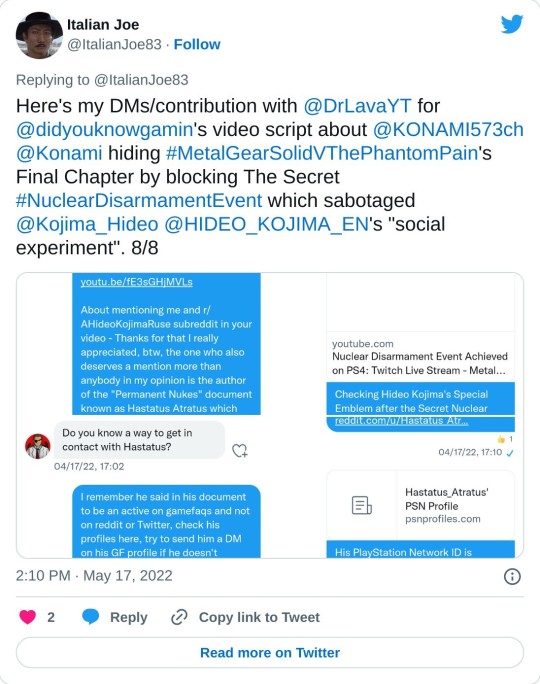
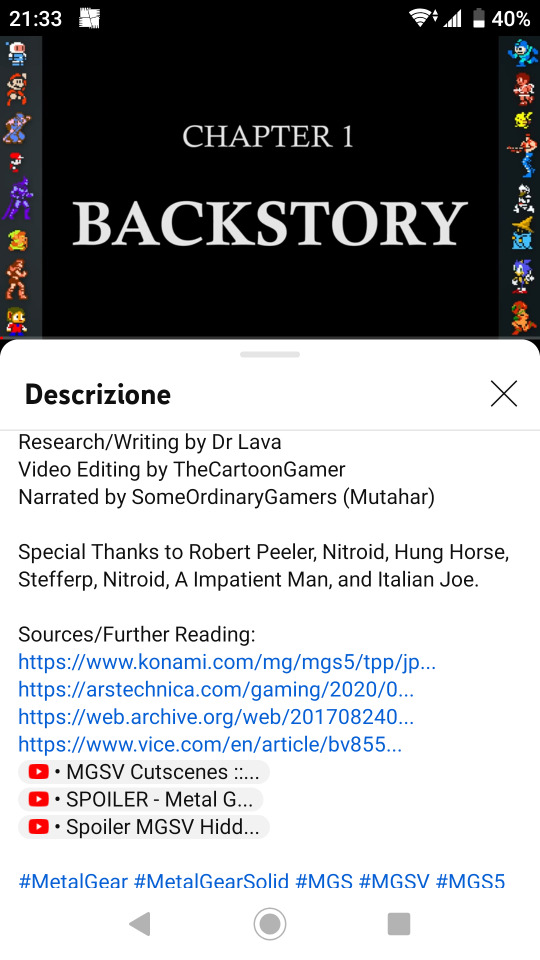
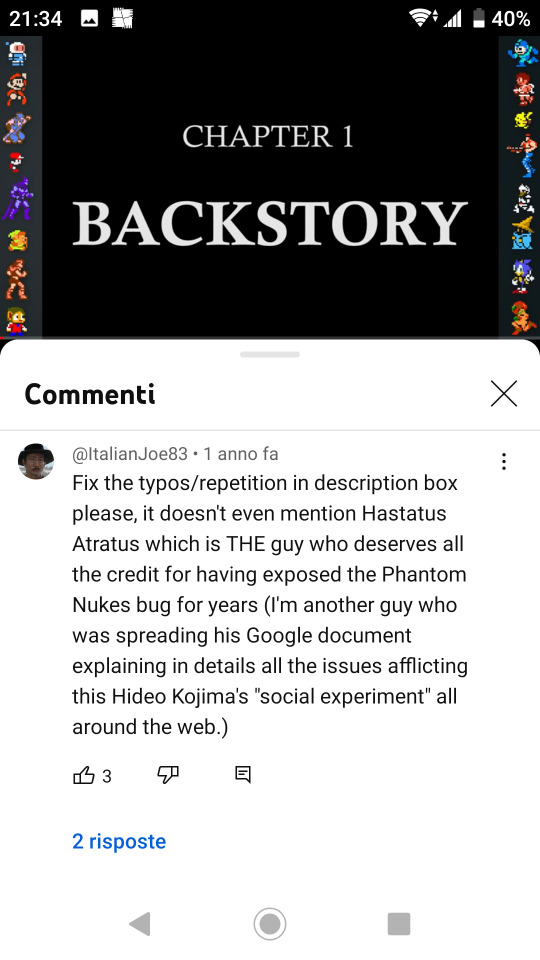

...and here's a now "Deleted User" Hung Horse's direct message reply to me on Discord in which he didn't just confirmed his awareness of this Google document existence but he also admitted to have took inspiration from Hastatus Atratus' monumental work into exposing Konami's agenda (way long before anybody else) for his group's activities...


...thus, everything else the audience is being shown and told in this DidYouKnowGaming's YouTube video outside from my contribution (which goes by timestamp 17:42 up to 18:26) should be considered as to being approved by/affiliated with Konami Digital Entertainment in official capacity before the final upload...
Note: this "Brain Structure" Episode #24 [ENGLISH] in which Hideo Kojima (voiced by Aki Saito) has a conversation with the Ricardo "Chico" Valenciano Libre's japanese voice actress Kikuko Inoue may also cause some "conflicts" of massive magnitude with the "good listener's" "internal timeline" starting at 35:22 up to 36:56 in particular "for a special reason."
Be aware of all this facts while you're looking for the Truth on the r/AHideoKojimaRuse subreddit...
..."Hombre"
youtube
#secret#plot twist#gaming#history#Punished “Venom” Snake#Ricardo “Chico” Valenciano Libre#metal gear solid v the phantom pain#metal gear solid v ground zeroes#metal gear solid peace walker#venom snake#Ricardo Valenciano Libre#punished snake#snake#mirror#butterflies#butterfly#a hideo kojima game#hideo kojima#metal gear#@ItalianJoe83#portopia renzoku satsujin jiken#the portopia serial murder case#A Hideo Kojima Ruse#metal gear solid v#metal gear solid 5#Chico#Metal Gear Solid V Experience#P.T. Concept Movie#P.T. Silent Hills#Hombre Nuevo
7 notes
·
View notes
Text
0 notes
Photo

Series: Meitantei Yumemizu Kiyoshirou Jiken Note Artist: Enue Kei Publication: Nakayoshi Magazine (02/2006) Details: All-Star Calendar (October) Source: Scanned from personal collection
#meitantei yumemizu kiyoshirou jiken note#yumemizu kiyoshirou#iwasaki ai#iwasaki mai#iwasaki mii#enue kei#kei enue#hayamine kaoru#kaoru hayamine#scan: hotwaterandmilk#furoku#nakayoshi#00s manga#shoujo manga#detective manga#mystery manga#manga fashion#00s aesthetic#manga scans#halloween
44 notes
·
View notes
Photo


‘Sherlock Holmes: Hakushaku Reijō Yūkai Jiken‘ [ シャーロック・ホームズ 伯爵令嬢誘拐事件]
[FC] [JAPAN] [FLYER] [1986]
via DISK-KUN
#gaming#advertising#sherlock holmes#Hakushaku Reijō Yūkai Jiken#famicom#action#mystery#japan#flyers#towa chiki#video games#1986
133 notes
·
View notes